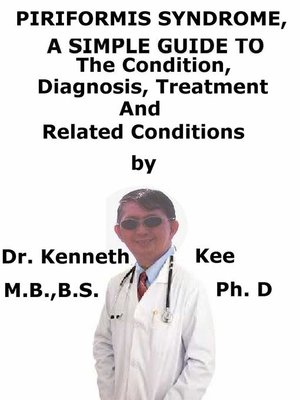Piriformis Syndrome, a Simple Guide to the Condition, Diagnosis, Treatment and Related Conditions
ebook
By Kenneth Kee

Sign up to save your library
With an OverDrive account, you can save your favorite libraries for at-a-glance information about availability. Find out more about OverDrive accounts.
Find this title in Libby, the library reading app by OverDrive.



Search for a digital library with this title
Title found at these libraries:
| Library Name | Distance |
|---|---|
| Loading... |
This book describes Piriformis Syndrome, Diagnosis and Treatment and Related Diseases
Piriformis syndrome is a medical disorder of sciatic nerve entrapment at the level of the ischial tuberosity.
This is a disorder featured by sciatic symptoms (leg pain) due to extra-pelvic sciatic nerve compression at the hip
Pseudo-sciatica, wallet sciatica, deep gluteal syndrome and hip socket neuropathy are other terms used for piriformis syndrome.
While there are possible multiple factors contributing to piriformis syndrome, the medical manifestation is fairly constant, with patients often reporting pain in the gluteal/buttock region that may shoot, burn, or ache down the back of the leg (i.e. sciatic-like pain).
Also, numbness in the buttocks and tingling sensations along the distribution of the sciatic nerve is not infrequent.
The sciatic nerve travels just next to the piriformis muscle, which functions as an external rotator of the hip.
Whenever the piriformis muscle is irritated or inflamed, it also involves the sciatic nerve, which then causes sciatica-like pain.
This syndrome normally begins with single-leg pain, tingling, or numbness in the back and buttock area that can travel down the back of the leg following the sciatic nerve and cause nerve pain.
Risk factors for piriformis syndrome may be these, which often happen due to sports injuries:
1. Inflammation (any cause such as overuse, sprain)
2. Trauma (usually blunt trauma to the buttocks and compression of the wallet in the back pocket - wallet sciatica)
3. Hematoma
4. Scar formation
Persons who develop these in or near the piriformis muscles are also at risk:
1. Cysts
2. Tumors
3. Pseudo-aneurysms
Causes of piriformis syndrome are:
1. Trauma to the hip or buttock area
2. Piriformis muscle hypertrophy (often seen in athletes during periods of increased weightlifting necessities or pre-season conditioning)
3. Sitting for prolonged durations (taxi drivers, office workers, bicycle riders)
4. Anatomic anomalies:
a. Bipartite piriformis muscle
b. Sciatic nerve course/branching variations with respect to the piriformis muscle
Patients will often manifest with symptoms of sciatica, and it can often be hard to distinguish the origin of the radicular pain due to spinal stenosis versus the piriformis syndrome.
The pain may spread into the back of the thigh, but at times it may also happen in the lower leg at dermatomes L5 or S1.
The patient may also have symptoms of buttock pain, and normally the palpation may show mild to moderate tenderness around the sciatic notch.
By doing FAIR (flexion, adduction, and internal rotation) maneuver, the doctor may be able to reproduce the patient's symptoms.
The FAIR maneuver causes the piriformis muscle to be on tension
The FAIR test is done by evaluating the patient in the supine position.
Then the doctor would ask the patient to flex the hip and move it along the midline.
At the same time, the doctor should rotate the lower leg.
This maneuver will increase tension to the piriformis muscle.
There is no definitive test for piriformis syndrome.
Tests such as X-rays can exclude bone fractures. CT, MRI (magnetic resonance imaging), electromyography (EMG, neurography or electrophysiologic tests), and injection of trigger points in the piriformis muscle with an anesthetic (lidocaine) can help the doctor diagnose whether the symptoms are due to piriformis syndrome
The treatment involves short-term rest (not more than 48 hours), use of muscle relaxants, NSAIDs, and physical therapy.
Occupational treatment to...







